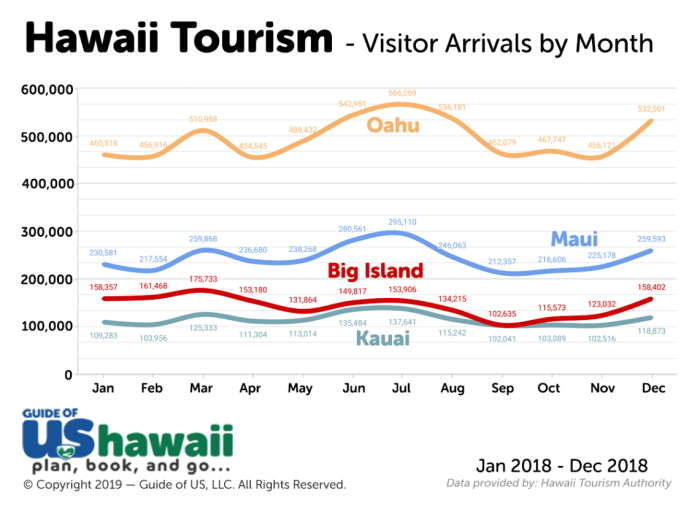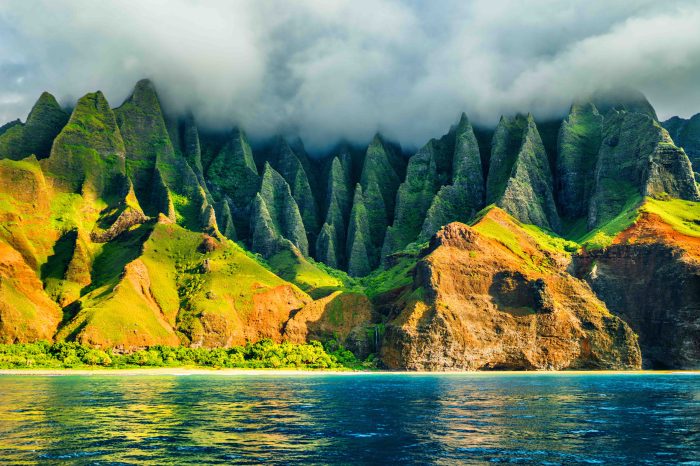Discover the best time to visit Hawaii, an archipelago renowned for its breathtaking landscapes, vibrant culture, and endless adventures. This comprehensive guide delves into the intricacies of Hawaii’s seasons, weather patterns, events, and activities to help you plan an unforgettable journey tailored to your preferences and budget.
Whether you seek sun-drenched beaches, lush rainforests, or vibrant festivals, Hawaii offers a myriad of experiences throughout the year. Read on to unravel the secrets of this tropical paradise and determine the ideal time to embark on your Hawaiian adventure.
Peak Season
Peak season in Hawaii typically falls between December and April, coinciding with the winter months in the Northern Hemisphere. This period offers a range of advantages and disadvantages for travelers considering a visit to the islands.
One of the primary benefits of visiting Hawaii during peak season is the optimal weather conditions. The islands experience warm and sunny weather with minimal rainfall, making it ideal for outdoor activities such as swimming, sunbathing, and hiking. Additionally, the increased availability of activities during peak season ensures that visitors have a wide range of options to choose from, including whale watching, luaus, and cultural events.
Advantages of Peak Season, Best time to visit hawaii
- Optimal weather conditions with warm temperatures and minimal rainfall.
- Increased availability of activities, including whale watching, luaus, and cultural events.
Disadvantages of Peak Season
However, peak season also comes with its drawbacks. The influx of tourists during this period can lead to higher costs for accommodations, rental cars, and activities. Crowds can also be a concern, especially at popular tourist destinations and during peak hours. Additionally, the limited availability of accommodations during peak season may require travelers to book well in advance to secure their preferred options.
- Higher costs for accommodations, rental cars, and activities.
- Crowds at popular tourist destinations and during peak hours.
- Limited availability of accommodations, requiring advance booking.
Off-Season

Visiting Hawaii during the off-season offers both advantages and disadvantages. Understanding these factors can help you make an informed decision about the best time to travel based on your preferences.
Planning your trip to Hawaii? Consider visiting during the shoulder seasons (April-May and September-October) for optimal weather and fewer crowds. Alternatively, if you’re looking for a tropical getaway with lush landscapes and rich culture, consider a Bali vacation. With its stunning beaches, ancient temples, and vibrant nightlife, Bali offers an unforgettable experience.
But don’t forget to check the best time to visit Hawaii before finalizing your travel plans.
Advantages:
- Lower costs: Off-season discounts on flights, accommodations, and activities can save you significant money.
- Fewer crowds: With fewer tourists, you’ll have more space to roam popular attractions, beaches, and hiking trails.
- More availability: Accommodations, rental cars, and tour bookings are more readily available during the off-season.
Drawbacks:
- Less favorable weather: Off-season months (typically October to April) can bring increased rainfall, higher winds, and rougher seas.
- Reduced availability of activities: Some activities, such as whale watching and snorkeling, may have limited availability or be unavailable during the off-season.
Weather Conditions
Hawaii’s tropical climate is characterized by warm temperatures year-round, with little variation between seasons. The average temperature in Honolulu ranges from 75°F (24°C) in January to 85°F (29°C) in August. Rainfall is heaviest from November to March, but showers are generally short-lived and infrequent. Humidity levels are typically high, especially during the summer months.
Rainfall
The wettest months in Hawaii are November to March, when the islands experience an average of 4 to 6 inches of rain per month. However, rainfall can vary significantly from island to island, with some areas receiving more than 100 inches of rain per year while others receive less than 20 inches.
If you’re planning a trip to Hawaii, aim for the shoulder seasons (April-May and September-October) to avoid crowds and high prices. While there, take some time to explore the beautiful adelaide oval , a historic cricket ground that hosts international matches and other events.
After your visit, return to Hawaii during its quieter months to enjoy the best weather and activities without the summer rush.
Humidity
Humidity levels in Hawaii are typically high, especially during the summer months. The average humidity in Honolulu ranges from 65% to 85%. High humidity can make it feel hotter than the actual temperature, so it is important to stay hydrated and take breaks from the sun during the hottest part of the day.
Impact on Travel Plans
The weather conditions in Hawaii can impact travel plans in several ways. Heavy rainfall can make it difficult to drive or hike, and high humidity can make it uncomfortable to be outdoors for long periods of time. However, the warm temperatures and sunshine make Hawaii a great destination for year-round travel.
For a tropical escape, Hawaii offers year-round warmth, but the best time to visit is during the shoulder seasons (April-May and September-October) to avoid crowds. If you’re planning a trip to New York City, consider staying at 432 Park Avenue , a luxurious residential skyscraper with stunning views of Central Park.
After exploring the Big Apple, return to Hawaii during the winter months (November-March) for whale watching and surfing.
Events and Festivals: Best Time To Visit Hawaii
Hawaii’s vibrant culture is reflected in its numerous events and festivals throughout the year. These events offer unique opportunities to immerse oneself in the local traditions, music, dance, and cuisine.
The best time to visit Hawaii for events and festivals depends on personal interests. Some popular events include:
Merrie Monarch Festival
- Dates: April
- Location: Hilo, Big Island
- Description: A week-long celebration of hula, featuring competitions, workshops, and performances by renowned hula masters.
Hawaii International Film Festival
- Dates: November
- Location: Honolulu, Oahu
- Description: A showcase of local and international films, with screenings, workshops, and Q&A sessions with filmmakers.
Honolulu Festival
- Dates: March
- Location: Honolulu, Oahu
- Description: A multi-day celebration of Hawaii’s diverse cultures, featuring parades, live music, cultural performances, and food stalls.
Kona Coffee Cultural Festival
- Dates: November
- Location: Kona, Big Island
- Description: A celebration of the world-renowned Kona coffee, with farm tours, tastings, and workshops.
Activities and Attractions

Hawaii is a year-round destination with diverse activities and attractions. The best time to experience specific activities may vary depending on the season due to factors like weather conditions and availability.
During the peak season (May to October), popular activities include:
- Surfing: The waves are typically larger and more consistent during this time.
- Snorkeling and scuba diving: The water is usually calmer and clearer, providing excellent visibility.
- Whale watching: Humpback whales migrate to Hawaii’s waters during the winter months.
In the off-season (November to April), activities such as:
- Hiking: The trails are less crowded and the weather is cooler.
- Golfing: The courses are typically less expensive and more accessible.
- Visiting historical sites: The cultural attractions are less crowded.
The weather conditions can significantly impact the enjoyment of outdoor activities. For example, heavy rainfall may make hiking trails muddy and slippery, while strong winds can affect water activities like surfing and snorkeling.
Availability of certain activities may also vary depending on the season. For instance, whale watching is only possible during the winter months, while some hiking trails may be closed due to weather conditions.
Budget Considerations

Visiting Hawaii can be an expensive endeavor, but there are ways to save money and budget for a memorable trip. The cost of your trip will vary depending on the time of year you visit, the length of your stay, and your choice of activities.
Here are some factors that influence travel expenses in Hawaii:
Airfare
- Airfare to Hawaii is typically higher during peak season (May-October) and lower during off-season (November-April).
- Flying into Honolulu (HNL) is generally cheaper than flying into other Hawaiian islands.
- Consider flying into a neighbor island (Kauai, Maui, or the Big Island) and then taking an inter-island flight to Oahu.
- Look for deals and discounts on airfare by signing up for airline newsletters and using travel search engines.
Accommodations
- Hotel rates in Hawaii are typically higher during peak season and lower during off-season.
- Consider staying in a vacation rental, condo, or guesthouse instead of a hotel.
- Look for discounts and deals on accommodations by booking in advance or through travel websites.
- Consider staying in a hostel or bed and breakfast for a more budget-friendly option.
Activities
- The cost of activities in Hawaii can vary widely depending on the type of activity.
- Many popular activities, such as whale watching, snorkeling, and hiking, are free or low-cost.
- Consider purchasing a Hawaii Activities Pass, which offers discounts on a variety of activities.
- Look for free or low-cost activities, such as visiting museums, attending cultural events, or simply enjoying the beaches.
Tips for Saving Money
- Travel during the off-season (November-April) for lower airfare and hotel rates.
- Consider staying in a vacation rental, condo, or guesthouse instead of a hotel.
- Look for discounts and deals on airfare, accommodations, and activities.
- Take advantage of free or low-cost activities, such as hiking, snorkeling, and visiting museums.
- Pack your own snacks and drinks to save money on food and beverages.
- Consider renting a car to explore the islands at your own pace and save on transportation costs.
- Take advantage of Hawaii’s public transportation system, which is affordable and efficient.
Personal Preferences

When determining the best time to visit Hawaii, your personal preferences should be a key consideration. Factors such as your travel style, interests, and budget can significantly influence the ideal time for your trip.
Travel Style
If you prefer a relaxed and leisurely vacation, the off-season months (April-May and September-October) offer a quieter and more intimate experience. You’ll encounter fewer crowds, allowing you to enjoy the islands’ natural beauty and attractions without the hustle and bustle. Conversely, if you’re seeking a lively atmosphere and vibrant nightlife, the peak season (December-March) is your best bet.
Interests
Your interests also play a role in choosing the best time to visit. If you’re an avid surfer or snorkeler, the summer months (June-August) offer the best conditions with calm waters and good visibility. For those interested in hiking or exploring the islands’ lush landscapes, the spring and fall months (April-May and September-October) provide ideal weather conditions with moderate temperatures and less humidity.
Budget
Finally, your budget can influence the best time to visit Hawaii. The peak season typically comes with higher prices for flights, accommodation, and activities. If you’re looking to save money, consider traveling during the off-season or shoulder months (November and March), when rates tend to be lower.
By considering your personal preferences, you can tailor your trip to Hawaii to create an unforgettable experience that aligns with your needs and desires.
Conclusion
In conclusion, the best time to visit Hawaii depends on your individual preferences, budget, and desired activities. Peak season offers optimal weather and a plethora of options, while the off-season provides tranquility, affordability, and unique experiences. By considering the factors discussed in this guide, you can tailor your trip to Hawaii to create lasting memories that will forever warm your heart.
FAQ Explained
When is the cheapest time to visit Hawaii?
Typically, the off-season months (April-May and September-October) offer the most affordable rates for flights and accommodations.
What is the best time to visit Hawaii for whale watching?
Whale watching season in Hawaii runs from November to May, with peak viewing opportunities in January and February.
Are there any major events or festivals in Hawaii during the summer?
Yes, the Honolulu Festival in July and the Big Island Chocolate Festival in August are popular summer events in Hawaii.